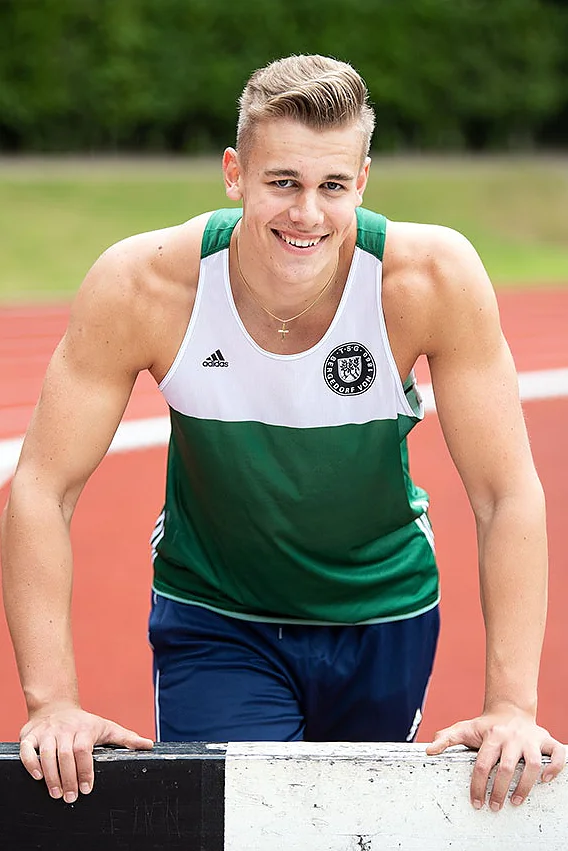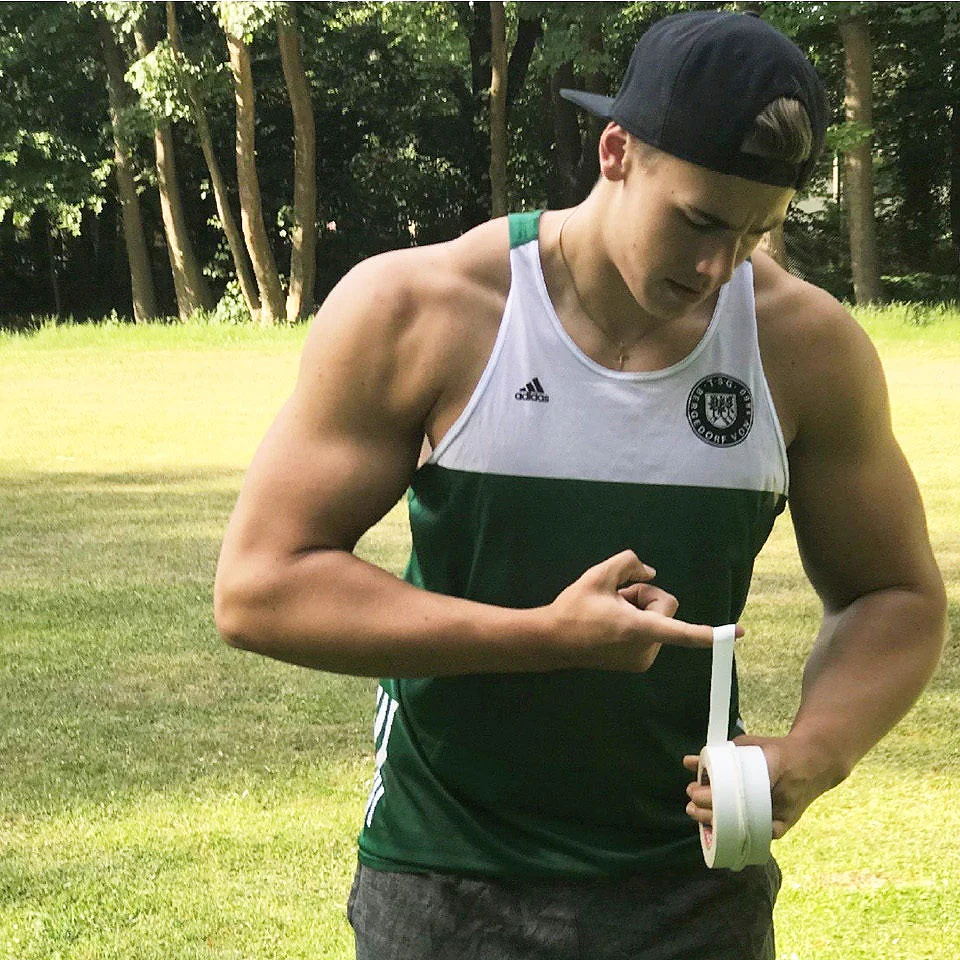Almost lovingly, the 1.98-meter tall and 100-kilogram model athlete reaches for the discus. Over and again Mika Sosna moves his fingertips – and makes intensive contact with the discus. It all happens following a ritual practiced a thousand times. Then he extends to his full ‘span’, rotates inside the ring and in milliseconds lets go of the 1.5-kilogram discus. The top talent from TSG Bergedorf in Hamburg, Germany managed the nearly perfect throw during a competition in Neubrandenburg, Germany. Under the watchful eyes of national coach Franka Dietzsch (former triple world champion in discus throwing) the 17-year-old achieved 64.05 meters. In 2020, no one in the age group U18 had reached such a result – worldwide. For the best performance of the day, he even received his first premium as a ‘semi-professional’: 100 Euro.
People
An amazing discus throw! Just recently, Mika Sosna threw the 1.5 kg disc at a distance of 64.05 meters. Thus, the 17-year-old student from Hamburg set a 2020 world record in his age group. A special tape technique supports his perfect grip.

Witters
“This feeling, when already while you let go of the disk you know that it will fly very far – It’s simply indescribable.”
World-class discus thrower in the age group U18
Dreaming about the Olympic Games 2028
“Beating my own Hamburg record from 2019 by more than eight meters is a great feeling. And you don’t throw a world annual best every day. However, this doesn’t mean that I hit the disc 100%. There’s much more to it,” explains the athlete from the ‘Eliteschule des Sports am Alten Teichweg’, a Hamburg sports school that enables particularly talented young people to optimally combine learning and high-performance sports. For example, training camps and competition trips have a fixed place on his time schedule. Mika’s key goal is to participate in the Olympic Games. If he remains injury-free and his performance curve continues to rise steeply, it could work out for 2024 (Paris). However, since throwers usually only develop their full ‘power’ at an older age, the games in Los Angeles four years later would probably be more realistic. In any case, the mega talent has already marked the days from July 21 to August 6, 2028 in his calendar.
90
kilometers per hour
Eight training units per week
Mika Sosna’s role model is Robert Harting, who in his career has won three world championships and one Olympic gold. When it comes to stature, the ‘little man’ could gain a bit more: In his prime (70.66 meters, 2012) the 2.01-meter tall, well-trained Berliner weighed around 126 kilograms. In any case, there is no lack of motivation for the youngster who started athletics seven years ago. Eight times a week he and his coach Juri Minor (65) – a former Soviet decathlon junior champion – meet on the sports field or in the weight room. Mika doesn’t want to reveal exactly how much ‘iron’ he moves. “In the thrower scene, we like to keep a secret about what exactly is on our training plan,” he says. “I do the deep squats with 130 kilograms on my shoulders. That’s an average value. However, I’m much stronger in the half-squat,” says Mika, who can easily do 100 push-ups in a row. His next season goal is to challenge the German U18 record, which stands at 65.87 meters.
“I’ve never trained a talent like Mika. I trust him to throw 70 meters.”
Coach, and former Soviet decathlon champion

A natural-born talent
If you burn plenty of calories during training sessions, of course, you must eat accordingly. “My parents have plenty to do with feeding me and my two younger brothers,” says Mika with a laugh. Depending on the training sessions, his daily intake is between 4,500 and 5,500 calories. However, the story that he would eat 15 eggs as a lunch snack, as recently mentioned in the daily press, is only half the truth. “Yes, it did happen once, but normally I eat a high-protein diet, which is a lot more balanced,” he says. The talent of the German Olympic hope is certainly inherited: In 2019, his 72-year-old grandpa Vaclav was senior discus world champion for his home country Czech Republic. And as a teenager, his mother Michaela (47) was an excellent athlete in the 2.50-meter ring.
Adhesive tape for his “tools”
Training and technique are essential to be able to call up top performance during a competition. Furthermore, every athlete has a little ‘fad’ to be one step ahead of the competition. Mika Sosna has been relying on tesa fabric tapes for around a year – to wrap his valuable ‘tools’. “I tape the fingertips of the right hand first with 19 millimeter-wide ‘Extra Power Perfect’ and then turn it in a second winding with the adhesive side facing up. This way, I feel great adhesion to the discus,” Mika reveals. He employs the tesa fabric tape also for his second discipline, shot put – but there he uses a roll that is twice as wide. It stabilizes the fingers in the lower area. “According to the competition regulations, this is OK, you’re just not allowed to tape several fingers together to create a larger area,” he says. A successful approach: Mika also managed to improve the 42-year-old Hamburg record to an excellent 17.28 meters in shot put.
Matthias Naumann, Head of Marketing tesa Consumer & Craftsmen (Germany) is pleased to be able to support the ambitious competitive athlete: “We are happy to provide Mika with our products, which are normally used for home or garden repairs. It feels great to make a small contribution to help a young person fulfill his Olympic dream.”
The adhesive champion for athletes
Plasters, compresses, cool-packs, adhesive tapes: This is what many athletes – in addition to their specific equipment – carry along in their sports bags. Before Skeleton sledger race down the ice channel – face-down and with up to 145 kilometers per hour – they tape a foam mat to the sharp-edged metal frame. This makes the rough ride a little more endurable and the device more aerodynamic. Ice hockey players prepare the blades of their sticks with tape – as a protection for the wood and for better guidance of the puck. Pole vaulters use fabric tapes to wrap the glass fiber rods for a better grip. Furthermore, like high jumpers, long jumpers, and triple jumpers, they stick colored marks to the edge of the tartan track. In the Japanese sword fighting art Iaido, the two competition fields must be marked in red or white. And since most conventional sports halls are geared towards handball, volleyball, and basketball – but there is usually no dedicated space for Iaidoka – the taping masters have to come in before each tournament …

“We’re happy to make a small contribution to fulfilling a young person’s Olympic dream.”
Head of Marketing tesa Consumer & Craftsmen (Germany)